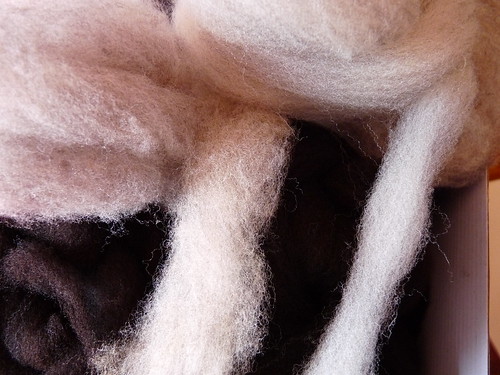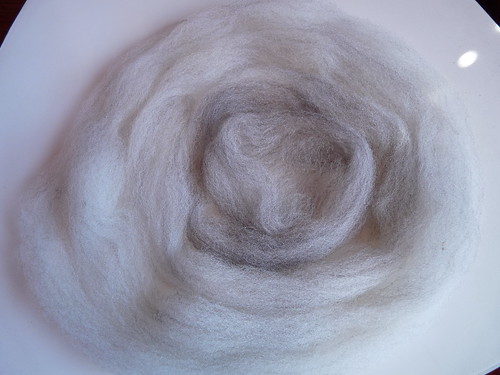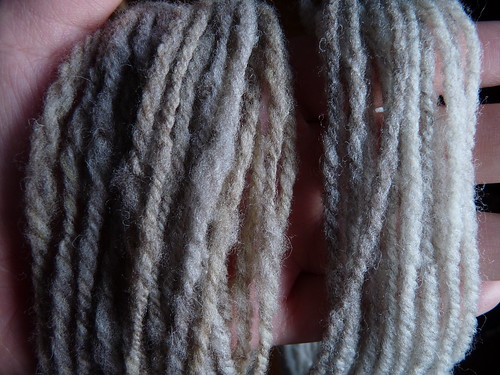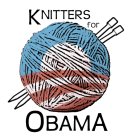This was going to be part of my last post, but it got way too long! If you hadn't seen it, I took this wonderful Romeldale fleece from Peeper Hollow Farm...

(actual photo of Hartley the sheep whose fleece is in the bag!)
...separated it into pieces and scoured it, intending to handcard the fleece for spinning into a heathery grey. I was hoping the handcards would leave me with a evenly colored, airy, squishy yarn to take advantage of the crimpy life in the fleece-- but I had a lot of problems with evenness and bumps. After a few rolags on the handcards I decided to comb a sample on the big combs, and unfortunately both cards and combs weren't quite right. I did find the difference between the preps interesting though and figured it's always fun to share :)

Rolag from handcards pulled into roving, left; sliver pulled off of combs, right
It's easy to see how clean the sliver is on the right with all of the waste fibers removed-- it's also easy to see the "jumbly" nature of handcarded fibers (along with shorter and longer bits and bumps) as well. I prefer a smoother fiber prep (using combs)-- but combs aren't always going to produce exactly what you want, either.

Notice how the sliver gets darker towards the center? The Romeldale staples were grey and white... apparently, the whiter fibers in the fleece were longer than the grey and pulled off the combs first. Even after I planked and relashed the straightening combing back on for additional combing, the fibers again pulled off white to dark.
I try not to buy variegated fleeces as it is hard to keep the colors consistent on the combs, but since the Romeldale staples were half white, half grey I didn't think I'd have that problem. Wrong ;)
So I ended up with a few rolag-to-rovings and a spectrum shaded sliver (five times fast!)... for fun I spun each on a spindle and navajo plied, just to keep the color gradation intact.

It's easy to see the difference-- the carded prep on the left is less smooth, has more bumps and neps where the combed prep on the right spun very evenly and at a finer weight (same spindle). Usually when spinning I would try and pull out large bumps in the fiber or try and even them out-- but kept them in the carded yarn both to show what was left in the fiber once prepped (vs combed) and also because I'm less able to stop and start when spindling :)
I honestly don't think one is better than the other-- I like how airy the carded prep spun and its rustic, evenly colored look, and I also like how smooth and effortless it was to spin the combed prep. It is just kind of fun to see the difference, same fiber in but two different swatches out.

I steamblocked these instead of wet finishing, I think the carded prep may look even more cohesive once wet blocked. Looking closely at the carded swatch, you can see towards the center where I changed rolags and one was browner/less grey than the other... small batch even blending can be difficult on both handcards and combs.
Best of all though is the light to dark transition the combed swatch takes, with the bulk a mix of white and grey.

Easier to see the difference with the edges folded together :)
I buy fleeces with the longrange intention of spinning for a sweater with them-- but not variegated sweaters. Sampling like this has given me a few insights: I need to practice more on the handcards because I don't know if it's me or the technique that is the problem when carding out a reasonably smooth rolag/roving from fleece. I also am now considering how to deal with spectrum colors in this Romeldale sliver-- I could separate the white from the grey when pulling off of the combs, leaving me with two distinct colors from one fleece. I could also try and handcard the slivers pulled off of the combs for an even color, maybe eliminating both the problem with waste/bumps and uneven color.
I actually love ending up with more things to think about :)
Til then, miss you.

(actual photo of Hartley the sheep whose fleece is in the bag!)
...separated it into pieces and scoured it, intending to handcard the fleece for spinning into a heathery grey. I was hoping the handcards would leave me with a evenly colored, airy, squishy yarn to take advantage of the crimpy life in the fleece-- but I had a lot of problems with evenness and bumps. After a few rolags on the handcards I decided to comb a sample on the big combs, and unfortunately both cards and combs weren't quite right. I did find the difference between the preps interesting though and figured it's always fun to share :)

Rolag from handcards pulled into roving, left; sliver pulled off of combs, right
It's easy to see how clean the sliver is on the right with all of the waste fibers removed-- it's also easy to see the "jumbly" nature of handcarded fibers (along with shorter and longer bits and bumps) as well. I prefer a smoother fiber prep (using combs)-- but combs aren't always going to produce exactly what you want, either.

Notice how the sliver gets darker towards the center? The Romeldale staples were grey and white... apparently, the whiter fibers in the fleece were longer than the grey and pulled off the combs first. Even after I planked and relashed the straightening combing back on for additional combing, the fibers again pulled off white to dark.
I try not to buy variegated fleeces as it is hard to keep the colors consistent on the combs, but since the Romeldale staples were half white, half grey I didn't think I'd have that problem. Wrong ;)
So I ended up with a few rolag-to-rovings and a spectrum shaded sliver (five times fast!)... for fun I spun each on a spindle and navajo plied, just to keep the color gradation intact.

It's easy to see the difference-- the carded prep on the left is less smooth, has more bumps and neps where the combed prep on the right spun very evenly and at a finer weight (same spindle). Usually when spinning I would try and pull out large bumps in the fiber or try and even them out-- but kept them in the carded yarn both to show what was left in the fiber once prepped (vs combed) and also because I'm less able to stop and start when spindling :)
I honestly don't think one is better than the other-- I like how airy the carded prep spun and its rustic, evenly colored look, and I also like how smooth and effortless it was to spin the combed prep. It is just kind of fun to see the difference, same fiber in but two different swatches out.

I steamblocked these instead of wet finishing, I think the carded prep may look even more cohesive once wet blocked. Looking closely at the carded swatch, you can see towards the center where I changed rolags and one was browner/less grey than the other... small batch even blending can be difficult on both handcards and combs.
Best of all though is the light to dark transition the combed swatch takes, with the bulk a mix of white and grey.

Easier to see the difference with the edges folded together :)
I buy fleeces with the longrange intention of spinning for a sweater with them-- but not variegated sweaters. Sampling like this has given me a few insights: I need to practice more on the handcards because I don't know if it's me or the technique that is the problem when carding out a reasonably smooth rolag/roving from fleece. I also am now considering how to deal with spectrum colors in this Romeldale sliver-- I could separate the white from the grey when pulling off of the combs, leaving me with two distinct colors from one fleece. I could also try and handcard the slivers pulled off of the combs for an even color, maybe eliminating both the problem with waste/bumps and uneven color.
I actually love ending up with more things to think about :)
Til then, miss you.








8 comments:
I love you blog already but this is definitely one of my all time favorite posts, thanks for sharing your insights! Yay for wool!!
I love the subtle gray stripes SO much! Are you sure you don't need a natural, very subtly self-striping sweater? Maybe just a stripey or fair isle yoke?
Thanks for sharing your processes. I love reading your blog! Your writing and photos are very inspiring.
Wow thanks for sharing. It surely is worth knowing these little differences.
I used to plank and recomb and all that, but I don't anymore. My thoughts:
1) No matter what, the longest fibers will always pull off ahead of the shortest. Planking doesn't somehow magically circumvent this "problem."
2) The work of recombing generates a tich more waste and is a lot of work for (imo) a marginally better top. I decided it wasn't worth the effort.
3) Tangential - I almost never recomb the waste on the comb. True, I can recover quite a bit of useable wool, but top made from initial waste - even when planked and recombed - has a noticeably different feel than virgin combings (shorter, coarser fibers in recombed waste).
I am enjoying watching you explore the process!
Thanks for the review on the wool scour, too, I am expecting a giant load of Romney soon (going to have a mattress pad made for my king size bed). I was planning to wash it myself to save some $.
Wow...so informative!! I have not tried combing yet but this was a great intro into the differences! I think a striped sweater would look great! I love natural colored yarn.
Hi,
I just wanted to drop you a comment, I've been reading your blog for a long time and just got my first half-fleece and your blog has proved very helpful for how to process it properly.
Thanks so much for keeping up your blog and posting so much helpful info.
~Sadie
Hello,
I'm reaching out with a sense of urgency and a touch of frustration in the world with global inflation, given the pressing nature of the opportunities at hand. Fresh resources have been made available to cash out discreetly from your comfort zones, and they promise to be game-changers for anyone ready to seize them. Here's what's on offer:
- Newly updated tools and the latest plugins
- Fresh US and worldwide Carding cvv for shopping spree that come with good balance
- Dumps+ PIN Track 1&2 101 201 - AT&T PIN and
- - EMV software reader and writer
- US & UK Leads To Reach Rich People
- Comprehensive information packages including SSN, DOB, and DL
- Extensive business and personal information from the US, UK, and Canada
- Tax documents like Form W-2
- SMTP,Mailer, RDP, Verified VPN Accounts
- Cryptocurrency peer-to-peer trade options, no need for KYC
- Full access to Australian CC, bank accounts and UK information
- Worldwide credit cards with substantial balances
- Extensive business and personal information from the US, UK, and Canada
- Online access to UAE and US, UK,EU bank logs with full documentation
- US bank statements and US, Canadian cheques, plus direct deposit forms
- Passport, DL, SSN, and ID forms for multiple regions
- All Social Accounts I.E Instagram,Facebook,X etc including their booster to have thousands of likes, views etc and more.
This is just a snapshot of what's available. The breadth of resources spans from social media account boosters to real-time location trackers, offering a multitude of avenues for strategic advantage.
Given your penchant for innovation and disruption, these resources could align perfectly with your ventures. I urge you to consider a long-term partnership that could leverage these assets to their fullest potential.
Please reach out privately if you're interested in exploring these options further. The window of opportunity is narrow, and acting swiftly could yield significant benefits.
For serious business inquiries, reach out to us via
Telegram:@legitmarketz or info@harmonyconsults.agency
Looking forward to do hear from you.
Ms Anna Foster
Post a Comment